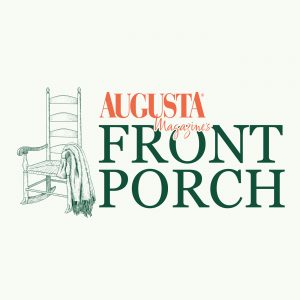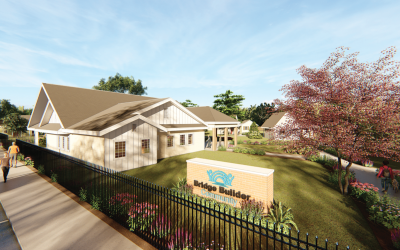Not all building projects can have such strangely auspicious origins as the baseball field Ray Kinsella builds in the middle of his cornfields. In the 1989 movie Field of Dreams, a mysterious voice tells the Iowa corn farmer, If you build it, he will come. Compelled by the mysterious voice, and despite the apparent irrationality of his choice, Kinsella builds the field. And then the magic truly begins.
Probably most of the Augusta skyline is the result of someone’s following the counsel not of a mysterious voice but of an experienced architect. Such are Nick Dickinson Jr. and Erin Armstrong, principal architects and managing partners at Dickinson Architects, a second-generation boutique design firm located in the heart of downtown Augusta.
From both Dickinson and Armstrong I learned, on the one hand, that successful architecture comes from what a thoughtful person would expect it to come from: a meticulous process of listening carefully to a client’s ideas, of translating them through multiple drafts into a single plan, of helping clients to see that efficiency and style do not conflict, of ensuring that industry codes are being followed, of communicating accurately with a host of other professionals necessary to a project’s completion. That’s to describe only some of the process—that part of an architect’s life we can probably guess.
On the other hand, they taught me something about being an architect that I never would have guessed.
Sometimes all it takes is a story or two about the eccentricities or egomania of a famed architect—say, Frank Lloyd Wright or Le Corbusier or Norman Foster—to prompt us to think that architecture must be a self-focused, self-exalting line of work. Have a look at Wright’s Fallingwater in the Pennsylvanian forest or at Foster’s Gherkin in the financial district of London, and it is hard to resist thinking that the whole business seems to be an exercise in making testaments to the ego, structures that, in effect, declare, “See who built this!”
To think this way, however, is decidedly oversimplified. Not all architects are egomaniacs, even though some egomaniacs are architects.
This is not to say that those at Dickinson Architects want to build forgettable or, dare I say it, ugly buildings; they don’t. Nevertheless, here is the key insight they gave me—the something I wouldn’t have guessed: From Dickinson and Armstrong’s point of view, architecture is not about the architect, nor even buildings, per se. To them, it’s about people. The goal is to design a building that declares, “See those for whom this was built!” People precede projects.
“I like to think that what we’re doing helps make our community a better place, whether aesthetically or by giving an organization more tools to serve the community better,” said Armstrong, citing the new Ronald McDonald House as a particularly rewarding project.
I could tell that Armstrong had reflected rather deeply on the categories behind this remark. More important to her than to be remembered as one whose work altered this streetscape or that skyline in avant-garde ways is to be known as one whose work is humane and ameliorative, respectful of history and humanity.
She explained, for example, how the old cobblestone lanes, both their width and the radius of their curvature around corners, were determined by the reach of the mason’s arm. Now, compare that cobblestone lane to a poured concrete slab. What are we supposed to see?
“There’s not as much humanity in that [concrete slab] as in that cobblestone street,” she said, smiling. “So, there are inherent things in materials that speak to our humanity. There are some things that are universal.” Clearly, I was talking to something of a philosopher! That isn’t the primary qualification of an architect, of course, but it may suggest that, to Armstrong, an architect’s reward is akin to the joy one gets from helping someone else. Again, people precede projects.
That principle guides the work Dickinson Architects does not only in the community for clients, but also in the firm for its employees—particularly its interns.
“Architecture, as a field, is having a crisis about what to call [interns] because to so many people in other fields, “intern” means ‘unpaid’ or ‘still in school,’” explained Armstrong. But neither is true of the interns at Dickinson.
An internship here means “pursuing a license,” which includes meeting certain proficiencies, keeping track of the hours to meet them, and submitting all this paperwork to the licensing organization. The entire program is an investment in the firm itself in the hope that the interns will develop professionally so well that they’ll want to stay on board. Does this imply that Dickinson Architects may one day see its interns become partners?
“Yeah, I think that’s the whole point,” said Dickinson. “The longer we can keep them, the better off they are, the better off we are. Their role in the overall production is critical; without [them], we wouldn’t be able to do anything.”
The pendulum of appreciation swings the other direction, too. The firm’s four interns had much to say about the supportive environment that both Dickinson and Armstrong create.
Kelly Albrecht, for example, a seven-year intern, said her first internship elsewhere “was pretty different” from her intern experience at Dickinson, her first full-time job in the field. “Nick and Erin were really great mentors [in my pursuit of] licensure … and they still [are],” she said.
Because all the interns, as well as the two interior designers, spoke of Dickinson and Armstrong’s mentoring strengths, I wondered how they could both mentor and do their own work, too, not to mention nurture their own families at home.
“We try to treat this office as our family,” answered Dickinson. “We have personal relationships with our staff; that’s about the only way we’ve been able to have some sort of balance.”
Intern Chris Gosnell said, “You can definitely tell it started as a family business, and it still has that [ethos].” A perusal of the firm’s Instagram illustrates this family bond; one picture of them at Rio Cantina in North Augusta is accompanied with this caption: “Nothing like a little impromptu lunch with the work fam … #companyculture.”
Once again, people precede projects.
Where or how did Dickinson and Armstrong learn this principle? Was it, perhaps, through a learning module in one of their courses at Georgia Tech? Or was it by imitating the wonderful blend of camaraderie and professional expertise, à la Michael Scott, in The Office? Not likely. The answer is actually closer at hand, as usual, but sometimes we find it only in circuit—in a journey away from, and then back to, home.
“I ended up here [at Dickinson] the first time without really knowing what it was going to be like,” said Armstrong. That’s right, she interned under Dickinson’s father, Nick Dickinson Sr. “Then I went to grad school and decided to come back [because] they were interested in my development professionally and were willing to invest in me to help me in my career.” But Dickinson Sr. was not her only influential mentor. Dicksinson was a significant influence, too.
“[His] being here was a big part of the decision to come back. If personnel had been different and he [hadn’t been] here, I don’t think I would have wanted to,” she said. What was it exactly about Dickinson? Was it his “breadth of knowledge,” his “patience,” his “time-management”—some of the things the current interns said of him?
“Really, what it came down to for me is his compassion,” Armstrong said. “He is concerned about me as an individual and my work-life balance. … I think that flows into what he does as an architect, too, because we’re building spaces for people. People inhabit our spaces, our buildings, our designs.”
Was that, then, the chief kernel of wisdom from father to son? Tellingly, Dickinson was unable to point to only one bit of sage of advice from his dad.
“It wasn’t any one thing in particular,” he said. “It was an upbringing.”
I returned to my car with much to think about, remembering that Erin had said, “That’s what good architecture makes people do—think.” I stood outside the car and looked up at the buildings around me there at Broad and Eighth streets. There was the Imperial Theatre, once a vibrant entertainment venue before decades of dormancy, now alive again as an important artistic locus. And there, on either side of the theater, stand the city’s two most historic structures, the Marion Building and its neo-gothic cousin, the Lamar Building, Augusta’s tallest. Both are now abandoned.
From the iconic Lamar penthouse, my gaze fell back to the street and to that “giant” building’s neighbor, the humbler two-story building that is home to Dickinson Architects. It occurred to me then that this design firm succeeds by building people. Perhaps intern Rafa Becerra said it best:
“We have a good team that gets along. We always try to build each other up.”
— Photo by Amy J. OwenAppears in the January 2020 issue of Augusta Magazine.






